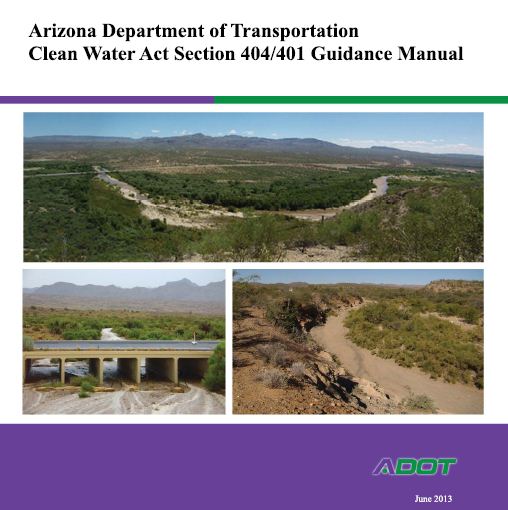The Arizona Department of Transportation has developed a manual to ensure compliance, provide consistency, and increase awareness of permitting and certification requirements for its projects under Sections 404 and 401 of the Clean Water Act. The ADOT Clean Water Act Sections 404/401 Guidance Manual, issued in October 2013, provides ADOT-specific guidance for obtaining and complying with required permits and certifications.

ADOT 404/401 Program Coordinator Julia Manfredi said the manual was developed to assist ADOT staff in project development as well as maintenance and construction. In response to a 2010 404 permit violation and a desire to improve its compliance efforts, ADOT added a 404/401 program coordinator to its staff, conducted a wide-ranging training program for hundreds of employees, and developed the Guidance Manual to provide additional guidance.
Manfredi said one of the purposes of developing the manual was to help determine when certification and permits are needed for maintenance activities, in addition to construction activities. Common “waters of the U.S.” that would be subject to regulation in Arizona include washes, rivers and streams, natural ponds, wetlands, and canals.
Construction activities that could trigger Section 404/401 compliance by ADOT include culvert or bridge construction, roadway and utility crossings and geotechnical borings. Examples of maintenance activities would include channel bank protection, wash realignment and channelization and removal of sediment buildup from culverts.
Step-by-Step Process Outlined
The guidance manual provides a step-by-step permitting decision process for transportation agency staff. It outlines the following process both for construction and maintenance activities:
- Step 1: Could “waters of the U.S.” be involved?
- Step 2: Will the activity involve discharges of dredged or fill material into “waters of the U.S.”?
- Step 3: Will a jurisdictional determination be needed? This may require preliminary calculation of impacts. Conduct a jurisdictional delineation if required.
- Step 4: Quantify impacts and determine the type of Section 404 permit that is needed: either nationwide or individual permit.
- Step 5: Prepare the Section 404 permit application and determine if a preconstruction notification is required for a nationwide permit. Submit the application to the Corps.
- Step 6: Determine Section 401 certification required – whether conditionally or individually certified – and acquire certification.
The manual also provides information on staff roles and responsibilities, timing of permit decisions, clarification on how Corps guidance applies to ADOT, information on the internal coordination processes for construction activities and for maintenance activities, documentation for non-notifying permits, and check lists and flow charts. A link to the manual has been distributed widely, including districts and district engineers, and has been the subject of a series of webinars, she said.
Lessons Learned
Manfredi said the manual, which took about six months to develop, is currently in use and has been well-received by ADOT staff and regulatory agencies. She said it has helped to simplify the process and empower those required to make permit decisions. The process of developing the manual went smoothly, in large part because it was developed through a collaborative effort of ADOT staff and district offices, the Corps, and the Federal Highway Administration, she said.
She also noted that the manual – which includes a range of check lists and templates that are also available on the ADOT website – is a work in progress and will likely be updated on an ongoing basis. Future efforts will include ongoing compliance tracking and additional audience-specific training programs.
Manfredi said the manual could be used as a starting point for other state DOTs looking to document their own CWA Section 404/401 permitting processes – particularly western states in arid climates. The step-by-step process for permit decisions could be adapted for most any state, she added. ADOT anticipates the manual will help avoid permit violations and will help ensure better protection of resources by training staff how to better identify resources in the field. It will also serve as a streamlining tool by simplifying the process and allowing better use of time and resources within the agency, Manfredi said.
For more information, link to the Guidance Manual, and the ADOT Section 404/401 Procedures website or contact Julia Manfredi at [email protected].

